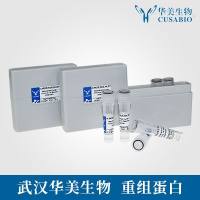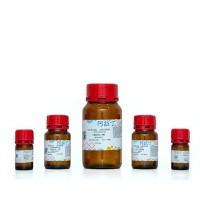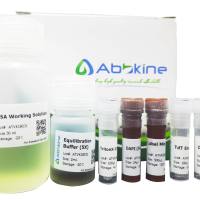Detection of apoptotic process in situ using immunocytochemical and TUNEL assays
互联网
1. INTRODUCTION
Endonucleolysis is considered as the key biochemical event of apoptosis, resulting in cleavage of nuclear DNA into oligonucleosome-sized fragments. The typical "DNA ladder" on agarose gel electrophoresis, however, can not provide information regarding the histological localization at single cell level. This can be done by immunocytochemical method (A) or by enzymatic in situ labeling of apoptosis-induced DNA strand breaks (TUNEL) (B).
-
Apoptosis was observed from invertebrates to lower and higher verterbrates, and intervenes both in physiological and in pathological states, such as normal cell turnover, embryogenesis, metamorphosis, thymic maturation and involution, neoplasm, etc. (1-4).
A mouse anti-DNA monoclonal antibody (mAb) conjugated with peroxidase (anti-DNA-POD) was used. This anti-DNA-POD mAb binds to single- and double-stranded, low molecular weight DNA fragments (mono- and oligonucleosomes), showing the internucleosomal degradation of genomic DNA occuring during apoptosis. The tests were performed on sections of rat, chichen, frog and fish thymus. All the thymus were fixed in Bouin's fixative and embedded in paraffin wax (3).
-
A) Immunocytochemical procedure
The low molecular weight DNA fragments as well as single strand breaks ("nicks") in high molecular weight DNA can be identified by labeling free 3’-OH termini with modified nucleotides in an enzymatic reaction. Terminal deoxynucleotidyl transferase (TdT), which catalyzes polymerization of nucleotides to free 3’-OH DNA ends in a template-independent manner, is used to label DNA strand breaks. Incorporated nucleotides are detected by a secondary antibody, conjugated with peroxidase. After substrate reaction, stained cells can be detected under light microscope. Utilizing the incorporation of fluorescein-labeled nucleotides, the use of fluorescence microscopy is also possible.
B) TUNEL in situ procedure
2. PROTOCOLS
A.2.1 Materials
Bouin's fixative (A1), alcohols, xylene, eukitt, Paraffin wax , anti-DNA-POD (A2), Phosphate Buffered Saline (PBS), 3,3'-diaminobenzidine tetrahydrochloride (DAB) tablets (A2), Phosphate-citrate buffer , Mayer's hematoxylin.
A.2.2. Methodology
-
A) Immunocytochemical procedure
-
-
1. Tissue sections are deparaffinated and bring up to 95% alcohol.
3. Inhibition of endogenous peroxidase 0.3% H2 O2 in methanol for 15 min.
4. Wash in running tap water for 10 min.
5. Wash in PBS (3x5 min).
6. Add anti-DNA-POD (1: 5; 1: 10) overnight at 4°C.
7. Wash in PBS (3x5 min).
8. Demonstration of peroxidase activity in a Petri dish: dissolve a DAB tablet (10 mg) in 40 ml of 0.1M citrate acid-sodium citrate buffer (pH 5.5), add 5 ml of H2 O2 and filter
9. Wash in running tap water for 5 min, deionized water.
10. Counterstain nuclei with Mayer's hematoxylin for 1 min.
11. Dehydrate through alcohols to xylene and mount in eukitt.
A.3. COMMENTARY
The immunocytochemical procedure described represents an original modification of the method for cell death detection by ELISA. Utilizing this new modified assay we are able to show the presence of apoptotic cells or cells involved in apoptosis in the thymus of all the species tested (Fig. 1).
-
A.3.1 Background information
The results are confirmed with both negative and positive controls. The negative controls are performed by substituting the primary antibody with non-immune sera. The positive controls are performed by inducing in vitro and in vivo apoptosis and then visualized the phenomenon with anti-DNA mAb. In vitro experiments are performed by treating human lymphocytes with 2-deoxyribose and rat thymocytes with dexamethasone 21-phosphate. In vivo experiments are performed by injecting Swiss male albine mice with dexamethasone 21-phosphate.
-
A.3.2 Anticipated results
The protocol require less than 90 min before the overnight incubation and 45 min after.
-
A.3.3 Time considerations
2. Ottaviani, E., Franchini, A. 1988. Ultrastructural study of haemocytes of the freshwater snail Planorbarius corneus (L.) (Gastropoda, Pulmonata) Acta Zool . (Stockh.) 69:157.
3. Ottaviani, E., Franchini, A., Franceschi, C. 1997. Evolution of neuroendocrine thymus: studies on POMC-derived peptides, cytokines and apoptosis in lower and higher vertebrates. J. Neuroimmunol . 72: 67.
4. Ueda, N., Shah, S.V. 1994. Apoptosis. J. Lab. Clin. Med . 124: 69.
B) TUNEL in situ procedure
B.2.1 Materials
proteinase K (pK) (A2), H2 O2 , TdT buffer (A1), TdT enzyme (A2), biotinylated dUTP (A2), TB buffer (A1), serum albumin (BSA) (A2), PBS, Extra-avidin Peroxidase (A2), AEC solution (A1), DNAse buffer (A1).
B.3. COMMENTARY
B.3.1 Background information
Moreover, as this procedure is quite complex, the use of commercial kits such as ApoTagTM (Oncor, Gaithersburg, MD, USA) and "In situ cell death detection Kit" (Boeringer-Mannheim, Germany), is recommended. Utilizing the last one, the incorporation of fluorescein-labeled nucleotides to DNA strands breaks, allows, using a fluorescence microscopy or a flow cytometer, to have a simple and fast method.
2. Gorczyca, W., Gong, J., Darzynkiewicz, Z. 1993. Detection of DNA strand breaks in individual apoptotic cells by the in situ terminal deoxynucleotidyl transferase and nick translation assays. Cancer Res . 52: 1945.
3. Gorczyca, W.,Tuziak,T., Kram, A., Melamed, M.R., Darzynkiewicz, Z. 1994. Detection of apoptosis-associated DNA strand breaks in fine-needle aspiration biopsies by in situ end labeling of fragmented DNA. Cytometry 15: 169.
4. Li, X., Darzynkiewicz, Z. 1995. Labelling DNA strand breaks with BrdUTP. Detection of apoptosis and cell proliferation. Cell Prolif . 28: 571.
-
B.2.2. Methodology
-
-
1. Tissue sections are dewaxed and rehydrate by heating at 60°C.
-
-
In this method, cytospin slides from cell suspension and cryopreserved tissues can also be utilized. For cytospin slides : i) fix air dried cell samples with a freshly prepared paraformaldeyde solution (4% in PBS, pH 7.4) for 30 min at room temperature; ii) rinse slides with PBS and incubate in permeabilisation solution (0.1% Triton X-100, 0.1% sodium citrate) for 2 min in ice and go directly to step 4. For cryopreserved tissues : i) fix tissue sections with 4% paraformaldeyde for 20 min at room temperature; ii) wash 30 min with PBS; iii) incubate slides in permeabilisation solution for 2 min in ice and go directly to step 4.
2. Wash in xylene and rehydrate through a graded series of ethanol and deionized water.
3. Stripp from proteins by incubation with 20 m g/mL pK for 15 min at room temperature.
4. Wash in deionized water (4x2 min).
5. Cover sections with 2% H2 O2 for 5 min at room temperature, to inactivate endogenous peroxidase.
6. Wash in deionized water.
7. Immerse in TdT buffer.
8. Add TdT (0.3 e.u./m L) and biotinylated dUTP in TdT buffer to cover the sections.
9. Incubate in humid atmosphere at 37°C for 60 min.
10. Stop the reaction by transferring the slides to TB buffer for 15 min at room temperature.
11. Wash in deionized water.
12. Cover the sections with 2% aqueous solution of BSA for 10 min at room temperature.
13. Wash in deionized water.
14. Immerse in PBS for 5 min.
15. Cover the sections with Extra-avidin Peroxidase diluited 1:10-1:20 in water.
16. Incubate for 30 min at 37°C.
17. Wash in deionized water.
18. Stain with AEC solution for about 30 min at 37°C.
B.3.2 Anticipated results
-
-
-
To perform each experiment using a blank, a negative and a positive control samples, is recommended. The blank sample is assessed passing from step 14 directly to step 17, in order to avoid the Extra-avidin Peroxidase incubation. The negative sample is assessed substituting step 8 as following: add biotinylated dUTP in TdT buffer to cover the sections (without TdT enzyme). The positive sample, in order to make sure that the method works, is assessed by digesting, after step 6, with DNAse buffer for 10 min at room temperature and wash extensively with deionized water before step 7.
-
-
The protocol require 3-4 hours excluding culture and preparation of tissue sections. Obviously, utilizing commercial kits the duration of method is reduced (2-3 hours for immunoenzymatic kit and 1-2 hours for fluorescein kit).
-
-
1. Gavrieli, Y., Sherman, Y., Ben-Sasson, S.A. 1992. Identification of programmed cell death in situ via specific labeling of nuclear DNA fragmentation. J. Cell Biol . 119: 493.
Appendix 1: Stock solutions
B.3.3 Time considerations
B.3.4 Key references
Appendix 2: Reagents
Appendix 3: Equipment
Fig. 1. Immunocytochemical staining with anti-DNA-POD mAb. Mouse thymus apoptosis induced after in vivo treatment with dexametasone 21-phosphate. Stained apoptotic thymocytes (arrowheads, Fig. 1a) and macrophage with stained phagocytized apoptotic bodies in cytoplasm (arrowhead, Fig. 1b) are shown.
Bar = 10 m m.







